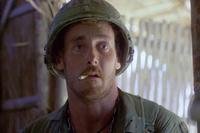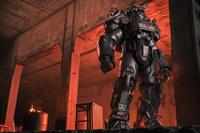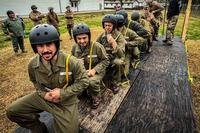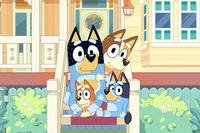
Hotel Transylvania 2, the sequel to director Genndy Tartakovsky's 2012 animated hit, opens in theaters this weekend. We talked to the film's Visual Effects Supervisor Karl Herbst about rapid technological changes in the movies and how hard it is for animation studios to find employees with the right technical training (which should be a hint for some of you veterans).
In the sequel, Dracula (voiced by Adam Sandler) has opened his hotel to humans but he's worried that his half-human grandson Dennis isn't showing signs of being a vampire and tries to put the kid through "monster-in-training" boot camp. Drac's father Vlad (voiced by Mel Brooks) comes to visit, discovers how much things have changed and things get complicated.
%embed1%
Over a twenty-year carreer, Herbst has worked on both animated films (including both Hotel Transylvania movies and Cloudy With a Chance of Meatballs) and live-action movies like Edge of Tomorrow, Men in Black II and X-Men 2. He spoke to us this week about the release.

It’s been three years since the release of the original Hotel Transylvania. What's changed about the technology that makes a difference between the two films?
For us, a lot of things have changed. We changed our animation software. We use Maya, but we have a lot of custom plugins. All of our characters needed to be upgraded for use on the new system.
Our lighting software is in-house. We have a proprietary version of Arnold. A lot had changed dramatically in the way surfaces respond to light. We had to get the material to work on all the surfaces and get the textures to work. All of the assets from the first film had to be upgraded into all of our new software, which took a bit of time. Then we start creating all of the new ones.

How much of your job is being an artist and how much of it is being an engineer? What's the split for you?
It changes over the course of the show. Part of a Visual Effects Supervisor's job is to work with our client, in this case our sister company Sony Pictures Animation. Initially, it’s mostly about creative, What are the characters and environments and props that we need to make? What kind of changes did we want to make from the look of the picture, from the first film to this one?
After that, it really becomes technical for a period of time, where we're designing pipelines to handle what the expectations are of this movie. If we have a lot of effects, you know our pipeline changes a little bit to accommodate that. Or if it's gonna be very animation-centric, which is what this one was, what can we do to support that? We go into work with our development team on new software pieces that we need or new pipeline pieces that we need to help make that easier.
We learned a lot from the first film about Genndy's style, which is a very pushed animation style. That really made it hard for certain types of things that required normal PhysX, which a lot of our simulation software uses PhysX. That’s the stuff of like how cloth is simulated and moves and how hair moves and how we create clouds and dust. Genndy doesn’t respond very well to “That’s how PhysX would make it move,” so we made a lot of changes so we could have a better looking cloth simulation, but also one that uses Genndy’s signature style.
We also changed things like the motion blur. Genndy comes from 2D background and really likes that style where it's a sharp leading edge and then the smear behind it. And, you know, in PhysX how a camera would take a picture of something moving, it would always be smeared on both sides, right? So we came up with a new motion blur methodology that allowed us to bias the motion blur so we could have that sharp, clean edge, but not get to the point where we're strobing on screen.
Those are the kinds of things we learned and developed along the way. Then the movie switches back into more of a creative role where a lot of my job is basically giving artistic notes on how we want cloth to move, hair to move, what the lighting should look like and how we composite the images together.
We tried to treat this movie like a little bit more like it was shot on location, so there were a lot of lens effects. We do most of that in the compositing stage. I give a lot of notes for that and watch the creative process until the end point, until Genndy is happy with it. That’s what makes it on film.

Along with your animation work, you’ve got a lot of live-action credits on movies like “Edge of Tomorrow.” Is the work becoming more similar?
Definitely. I mean we're using the same techniques generally speaking. What happens more often than not is that, in fully computer-animated films, we tend to take what we know about how we would do things for live action and then simplify it or design it.
An example is like a lens flare, something that happens in live action all the time. But if we just use a live action-looking lens flare in our animated movie, it tends not to fit in. What we end up having to do is design those elements by hand to try to get the look that we want.
On the crossover between live and animation: for somebody like myself (or even our CG supervisors, animation supervisors), we're using the same software and same technique. We're just approaching the final look of those things differently.

If someone’s coming out of the military, what kind of training and education should someone get if they’re interested in what your job? What's your advice to them?
I got into the industry in 1995. There weren’t very many schools that taught the stuff. I actually have an architecture background. I became a modeler for a company and luckily it was more of a mom-and-pop shop and I learned everything about how computer graphics got created and how to create a film or television commercial. I grew up through that and then became a digital effects supervisor.
These days, there are a lot of schools. There are a lot of technical terms and artistic arms in our building. We have people who are basically just programming and they're doing user interfaces so the artists can use the tools, or maintaining the data pipeline that runs our day and supports all of the data. We create terabytes of data and a lot of that has to be managed and readily accessible and stored correctly. There are people who are maintaining that all the time.
A production support technician is in an entry level job in our industry. They're managing how data goes in and out and how it gets represented to everybody who's on the team. Then you move into more tools development. For people who have a technical background coming from the military, that’s an avenue that would get them into the industry.
If they have an artistic skill, we let them use the tools on their own time to learn about the artistry side of it as well. If they show that they have the skill set, they usually get a chance to move forward and move up into one of those roles and get a chance on a movie to showcase what they can do.

When you were starting out in the late 90's, early 2000's, how much smaller was your team compared to the resources you have now?
Much smaller. Back when I started, if we worked on a live action film that had 200 effects shots in it, that was a lot, mostly because the cost of the hardware was very expensive and the software was very expensive.
On this movie, the team grew to be a little over 400 people at one point. To be honest, it would be a lot more fun if it was smaller because we could pay a lot more attention and have a lot more consistency, but the schedules these days dictate that we move at a much faster pace. We completed this film in about 18 months. That’s why the team grows so big. But these days, it's actually hard to find enough artists that have the skill set and have the talent to grow the team to that size.

Since there are so many more shops making animated films these days, I imagine that things have gotten really competitive on a creative level between people at different companies?
Super competitive. Over the last few years, a lot of our company has moved into Vancouver. We were about 1500 people in L.A. at one point and now we may have a couple hundred there with the rest of our company at our new headquarters in Canada. A lot of companies did that based on tax incentives and pressure from our clients.
Our clients all see the benefit of the tax incentives and they want us to have our people there. But, when you now have so many companies entering the same market, it's very hard to find people who will move there when they have a lot of choices of where they want to work. You have to be very attractive either by what you're paying, what the environment’s gonna be like or what kind of content you're creating.
If somebody really wants to work on a Genndy Tartakovsky animated film, we obviously have a draw and that’s how we were able to draw a lot of the animators we wanted. But it's still very difficult because there's so many competitive companies.




